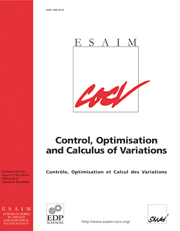Article contents
Approximation of the pareto optimal set for multiobjective optimal control problems using viability kernels
Published online by Cambridge University Press: 10 October 2013
Abstract
This paper provides a convergent numerical approximation of the Pareto optimal set for finite-horizon multiobjective optimal control problems in which the objective space is not necessarily convex. Our approach is based on Viability Theory. We first introduce a set-valued return function V and show that the epigraph of V equals the viability kernel of a certain related augmented dynamical system. We then introduce an approximate set-valued return function with finite set-values as the solution of a multiobjective dynamic programming equation. The epigraph of this approximate set-valued return function equals to the finite discrete viability kernel resulting from the convergent numerical approximation of the viability kernel proposed in [P. Cardaliaguet, M. Quincampoix and P. Saint-Pierre. Birkhauser, Boston (1999) 177–247. P. Cardaliaguet, M. Quincampoix and P. Saint-Pierre, Set-Valued Analysis 8 (2000) 111–126]. As a result, the epigraph of the approximate set-valued return function converges to the epigraph of V. The approximate set-valued return function finally provides the proposed numerical approximation of the Pareto optimal set for every initial time and state. Several numerical examples illustrate our approach.
Keywords
- Type
- Research Article
- Information
- ESAIM: Control, Optimisation and Calculus of Variations , Volume 20 , Issue 1 , January 2014 , pp. 95 - 115
- Copyright
- © EDP Sciences, SMAI, 2013
References
- 5
- Cited by


